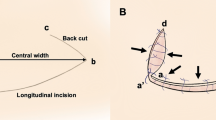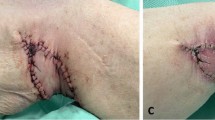Abstract
The Hatchet flap is a well-known flap used to cover round defects with primary closure of the donor sites in a V–Y fashion. This provides a stable coverage of the defect by a skin flap from the adjacent area and thus having similar color, texture, and sensation to the lost skin. Literature showed the application of the hatched flaps in facial, fingertip, pressure sores, and meningomyelocele reconstruction but not in the other anatomic areas. The aim of this study was to demonstrate the versatility and reliability of two types of hatchet flaps to reconstruct soft tissue defects at various anatomical regions of the body. Forty-six hatchet flaps were used in 40 patients to reconstruct defects located at scalp, face, neck, chest, axilla, back, sacrum, trochanter, genitalia, perineum, buttock, thigh, knee, foot, and fingertip. The causes of defects were infection, trauma, tumor excision, pressure necrosis, congenital meningomyelocele, chemical burn, and radiation. Mean follow-up period was 6.6 months. Hatchet type I flaps were advanced without undermining using the viscoelastic properties of the skin, while hatchet type II flaps were undermined before rotation advancement. All defects were successfully covered. The flaps survived completely. Partial dehiscence occurred at the donor site of three flaps but healed without problems after re-suturing. In conclusion, hatchet flaps are versatile flaps that provide a simple but efficient solution to defects of different etiologies located at different anatomical regions in the body. Minimal blood loss and short duration of surgery make them first option flaps for patients with co-morbidities.





Similar content being viewed by others
References
Jackson IT (2007) Forehead reconstruction. In: Jackson IT (ed) Local flaps in head and neck reconstruction, 2nd edn. Quality Medical, St. Louis, pp 47–100
Emmett AJ (1977) The closure of defects by using adjacent triangular flaps with subcutaneous pedicles. Plast Reconstr Surg 59:45
Reynaud JP (1983) Hatchet flap for the repair of cutaneous excisions on the nose. Ann Chir Plast Esthet 28:369
Horwath H, Roscic I, Falkensammer G, Engleder R (1989) Hatchet-form flap as a method of aesthetic reconstruction of the nose. Fortchr Kiefer Gesichtschir 34:151
Baron JL, Reynaud JP, Gary-Bobo A, Maya M (1990) Specificity of hatchet flaps in the laterofacial region. Ann Chir Plast Esthet 35:47
Tremblay JF, Bernestein SC (2001) Hatchet flap. Dermatol Surg 27:1049
Pan Y, Ai Y, Li H, Guo S (2004) Local hatchet flap for facial skin defects reconstruction in special areas. Dermatol Surg 30:1256
Gargano F, Alfano C (2005) Versatility of the hatchet flap in facial reconstruction. Acta Chir Plast 47:67
Yu TC, Desciak EB, Eliezri YD (2006) Bilateral hatchet flaps. Dermatol Surg 32:1279
Quillot M, Lodde JP, Pegorier O, Reynaud JP, Cormerais A (1994) A variant of island flaps for the covering of pressure sores: the hatchet flap: a props of 31 cases. Ann Chir Plast Esthet 39:469
Josvay J, Donath A (1999) Modified hamstring musculocutaneous flap for the coverage of ischial pressure sores. Plast Reconstr Surg 103:1715
Demirseren ME, Gokrem S, Ozdemir OM, Katircioglu A, Can Z, Serel S (2003) Hatchet-shaped tensor fasciae latae musculocutaneous flap for the coverage of trochanteric pressure sores: a new modification. Ann Plast Surg 51:419
Josvay J, Sashegyi M, Kelemen P, Donath A (2006) Modified tensor fascia lata musculofasciocutaneous flap for the coverage of trochanteric pressure sores. J Plast Reconstr Aesthet Surg 59:137
Schwabegger AH, Delfrari B, Apprich C (2006) Pedicled deltoid hatchet flap for treatment of pressure sore at the shoulder. Eur J Plast Surg 28:534
Josvay J, Bognar L (2003) Large lumbosacral meningomyelocele closure with gluteus maximus musculocutaneous hatchet flap. Eur J Plast Surg 25:378
Tuncali D, Barutcu AY, Gokrem S, Terzioglu A, Aslan G (2006) The hatchet flap for reconstruction of fingertip amputations. Plast Reconstr Surg 117:1933
Josvay J, Sashegyi M, Kelemen P, Donath A (2005) Clinical experience with the hatchet-shaped gluteus maximus musculocutaneous flap. Ann Plast Surg 55:179
Hayashi A, Maruyama Y, Saze M, Okada E (1998) The lateral thigh V–Y flap for repair of ischial defects. Br J Plast Surg 51:113
Gillies H, Millard DR (1957) The principles and art of plastic surgery. Little, Brown, Boston
Limberg AA (1946) Mathematical principles of local plastic procedures on the surface of the human body. Government Publishing House for Medical Literature, Medgiz, Leningrad, Quoted from reference 1
Dufourmentel C (1962) La fermeture des pertes de substance cutanee limitees. Le lambeau de rotation en L pour losange, dit “LLL”. Ann Chir Plast 7:61
Zimany A (1953) The bilobed flap. Plast Reconstr Surg 11:424
Esser FJS (1917) Island flaps. NY Med J 106:264
Behan FC (2003) The keystone design perforator island flap in reconstructive surgery. ANZ J Surg 73:261
Moncrieff MD, Thompson JF, Stretch JR (2010) Extended experience and modifications in the design and concepts of the keystone design island flap. J Plast Reconstr Aesthet Surg 63:1359
Lockwood TE (1991) Superficial fascial system (SFS) of the trunk and extremities: a new concept. Plast Reconstr Surg 87:1009
Author information
Authors and Affiliations
Corresponding author
Rights and permissions
About this article
Cite this article
Elshahat, A. The versatility of the hatchet flap in soft tissue reconstruction and a proposed new classification. Eur J Plast Surg 35, 351–357 (2012). https://doi.org/10.1007/s00238-011-0615-9
Received:
Accepted:
Published:
Issue Date:
DOI: https://doi.org/10.1007/s00238-011-0615-9




